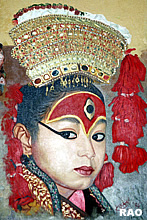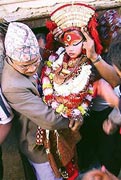 |
|
|
|
|
|
 |
| Kumari - The living Goddess |
| Indra Jatra Festival |
Koniya of Kumari Rath Yatra (southern parts' festival) and Thaniya Jatra (northern parts' festival)
 |
|
 |
Thousands of people, including tourists and children, were gathered on either side along the route of the chariot procession to watch this traditional chariot festival, a practice continued since time immemorial. The third day of Indra Jatra is considered the most significant of the festival because the living Goddess Kumari is taken out of the Kumari House and is paraded in a chariot.
As per tradition, before the Kumari's procession is taken out, Pancha Buddha or five priests (selected from Bajracharya community of Buddhists) offer special puja (prayers) to the Goddess at a secret function. Then along with the Goddess Kumari, Gods Ganesh and Bhairab are brought out of their respective residences in different chariots to the sound of traditional musical instruments. (An interesting detail is that the Kumari, Ganesh and Bhairab are selected from the Buddhist Shakya clan only).
Before the start of chariot festival, a goat is sacrificed for each wheel of the chariots and special pujas are offered. It is believed that after performing this special puja and sacrifices made, the chariots would become immune to any untoward incident throughout the procession.
The procession is called Koniya Jatra (southern parts' festival) in Newari. This is because the chariots are taken in procession through the southern parts of the city like Maru, Chikanmugal, Majimat, Jaisidewal, Jyabahal, Lagan, Brahma Tole, Humat, Kwahiti, Bhimsensthan and then back to Basantapur. Then on the day after, the chariots procession is taken out through the northern parts, and this the procession is known as Thaniya Jatra (northern parts' festival). Starting from the Kumari House at Basantapur, the chariots move through the places like Pyaphal, Yatkha, Nardevi, Tangal, Bangemudha, Ason, Keltole, Indrachowk, Makhan, Hanumandhoka and back to Kumari House.
Throughout the procession, Panche Baja, traditional musical band and army band and Saduljung Gulm (traditional Royal Army) also accompany the chariots. Raj Khadga (the ceremonial Royal Sceptre, representing the King) is carried along with the chariot.
An interesting part of the Jatra is that the various traditional masked dances are performed at Basantapur and other places along the route of the procession. Majipa Lakhe, Pulu Kisi and Mahakali dance (performed especially by people from Bhaktapur) are the most interesting parts of the festival, following the Kumari chariot today.
Whenever the chariot of Kumari reaches at the location of the images of God Bhairab installed at different points along the procession route, the public rush forward for a drop of Jaand (traditional liquor) poured from the Bhairab's mouth. This jaand from Bhairab is considered a holy offering on the occasion, Bhairab images along the route are installed with a pipe fixed on its mouth to make pouring of the liquor easier.
"Indra Jatra is the festival of God Indra in which the Kumari Jatra is just a part of it," says Tamrakar, adding that history books state that Jay Prakash Malla, the last Malla King of the Kathmandu Valley, started the chariot procession of living Goddess Kumari around 245 years ago. Indra Jatra is also mentioned in ancient religious texts of the Rhig Veda."
Newar community of the Valley invites their relatives and friends to their homes, as the day has come to be a day of a feasting. In the evening after the puja, the people go around different parts of the Valley lighting oil-fed lamps (Pala) at different parts of the city in memory of their family members who were dead within the past one year.